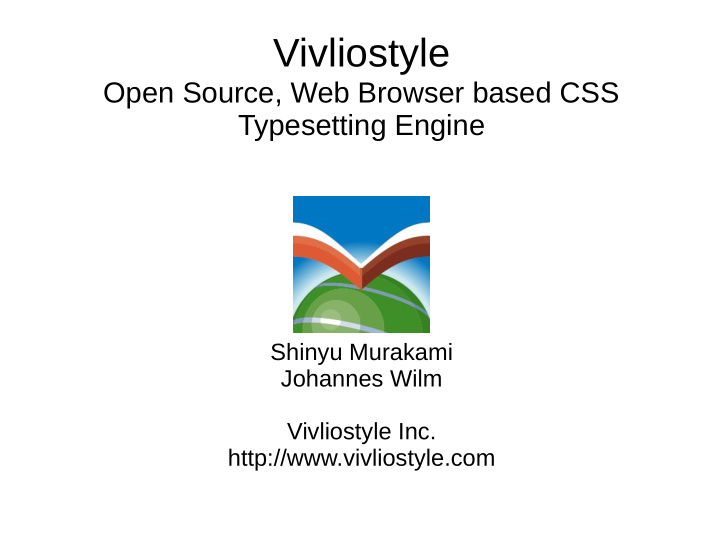



Vivliostyle Open Source, Web Browser based CSS Typesetting Engine Shinyu Murakami Johannes Wilm Vivliostyle Inc. http://www.vivliostyle.com
Typical input/output requirements for publishing Input: ● Word processor ● Web-based editor Output: ● Ebook ● Web ● Print
Formats used in workflow Input: ● Word processor: DOC/DOCX ● Web-based editor: (X)HTML Output: ● Ebook: EPUB (XHTML) ● Web: (X)HTML ● Print: PDF
Typical workflows Some examples: ● DOC → XML → XHTML/PDF ● DOC → LaTeX → PDF (but what about HTML/EPUB?) ● HTML → XML → XHTML/PDF ● HTML → XML → PDF → HTML Common issues with conversion: ● Labor intensive ● Every conversion is likely causing some problems. More conversions = more problems
One solution: Switch to XHTML as main format for long text content Input: ● Word processor: DOCX/DOC ● Web-based editor: XHTML Output: ● Ebook: XHTML ● Web: XHTML ● Print: XHTML
Style XHTML for output Cascading Stylesheets can format XHTML for different output ● Epub/Web: Existing CSS rules (first release 1996) ● Print: Additionally three CSS specs: – CSS Paged media – Generated Content for Paged Media – CSS Page Floats
Why has XHTML/CSS for print not had its breakthrough so far? There are existing solutions for XHTML/CSS for print: ● PDFreactor ● PrinceXML ● Antenna House Formatter ● Pagination.JS ● Simplepagination.JS
Renderer-from-scratch solutions In this category: ● PDFreactor ● PrinceXML ● Antenna House Formatter Issues: ● High development costs ● Use their own proprietary extensions to do print with CSS (not entirely inter- operable) ● Bugs/issues different in each browser/rendering engine, not easy to obtain visual feedback during document creation ● Cannot keep up with web browsers in terms of general features
Browser-as-PDF-renderer solutions In this category: ● Pagination.JS (sophisticated, requires CSS Regions) ● SimplePagination.JS (simpler, no need for CSS Regions) Advantages: ● Can run both headless on server and in the browser for direct visual feedback ● Lower development costs as all development is focused on JavaScript addons on top of existing rendering engines ● The CSS bugs that do exist are the same as those found in regular browsers Issues: ● Very book specific ● Configuration of all print-related settings through JavaScript function arguments, not CSS
The way forward 1. Create a Browser-as-PDF-renderer solution that is 1.generic in nature, 2.reads configuration options by parsing CSS, 3.Follows existing web standards 2.Participate in the creation of print-related specifications to ensure interoperability between solutions
Vivliostyle Current status
Regular browser rendering
Rendering using Vivliostyle.js
Including footnotes, headers and page numbers
Supports non-Latin text directions
Initial work on W3C specs
But will this work in the long-run? Common argument: “Browser makers don't care about print, and the example of CSS Regions in Chrome shows we cannot trust them to not remove features we need” Answer: “It is true that browser makers may not ever care about pages or print. But the 'Extensible Web Manifesto' [1] may help us get primitives useful to us. Even if we do not get them, browsers already contain enough general non-print features that can be reutilized for our benefit.” [1] https://extensiblewebmanifesto.org/
What is the Extensible Web Manifesto? ● A set of principles of how the creation of web standards should change, supported by many of the members of the CSS Working Group as well as the browser creators ● Fundamental change: – First, stable primitives JavaScript developers should first get access to stable primitives through defined specs, – Later specs on a higher level are developed in close feedback cycles with JavaScript developers who can implement the new features in JavaScript as polyfills Print specifications – may end up being implemented in browsers once fully stable, – or they may only ever be implemented in JavaScript. Either way, it will allow us to do rendering for print output using common browser engines
Vivliostyle Inc. Web: http://www.vivliostyle.com Email: info@vivliostyle.com Vivliostyle.js is developed by Toru Kawakubo and based on Peter Sorotokin's Adaptive Layout implementation
Recommend
More recommend